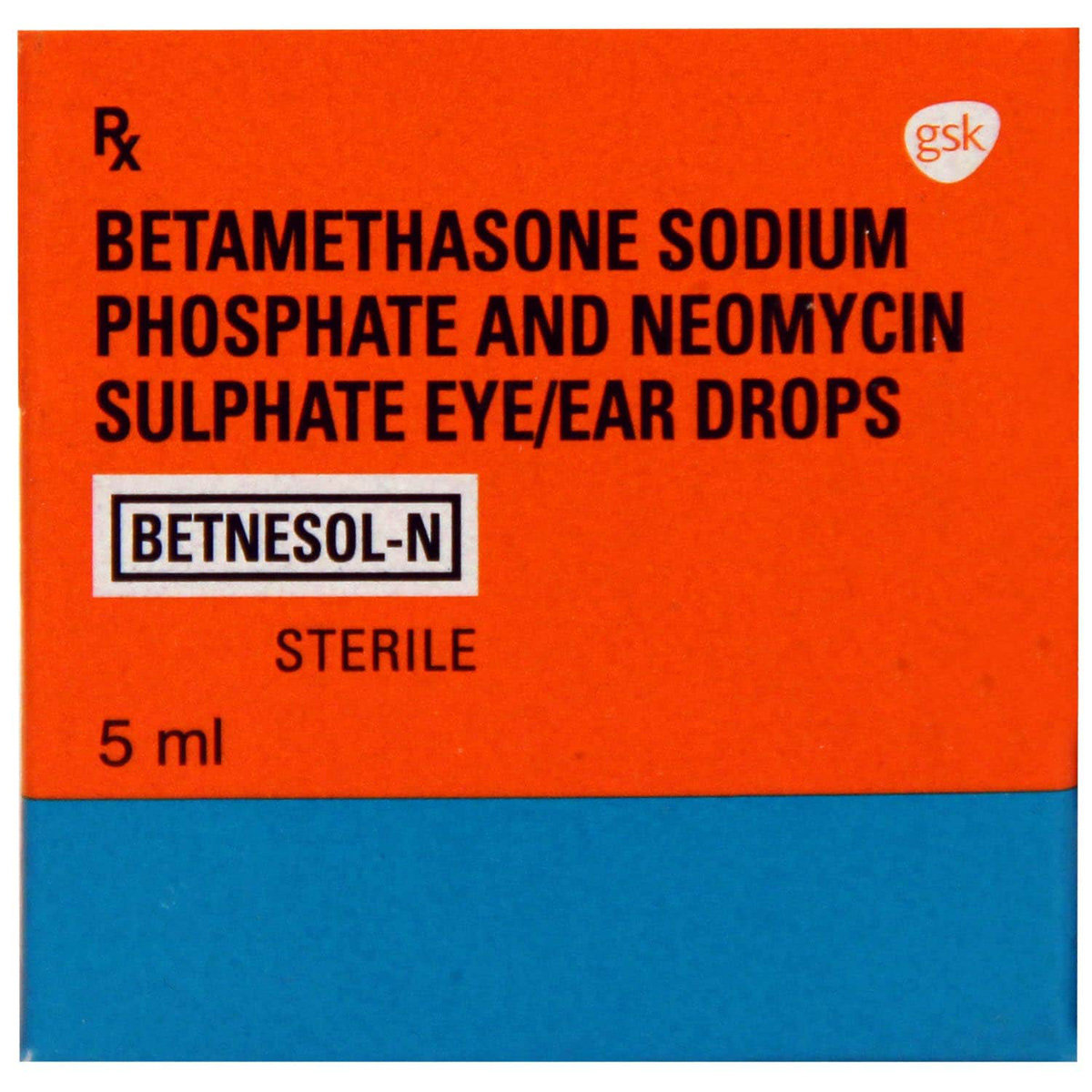Betaeno Eye/Ear Drops


MRP ₹12
(Inclusive of all Taxes)
₹1.8 Cashback (15%)
Provide Delivery Location
Online payment accepted
 Prescription drug
Prescription drugWhats That
Composition :
Consume Type :
Return Policy :
About Betaeno Eye/Ear Drops
Betaeno Eye/Ear Drops is a combination medicine used to treat bacterial infections of the eye and ear like allergic conjunctivitis (inflammation of the mucous membrane (conjunctiva) of the eye), uveitis (inflammation of the uvea-middle layer of the eye), marginal keratitis (inflammation of the cornea), blepharitis (inflammation of the eyelids), and otitis externa (inflammation of the ear). Betaeno Eye/Ear Drops may also be used to treat steroid-responsive inflammation of the ear and nose.
Betaeno Eye/Ear Drops is composed of two medicines: Betamethasone and Neomycin. Betamethasone belongs to the class of corticosteroids. It blocks the production of prostaglandins (chemical messengers) that make the affected area red, swollen and itchy. Neomycin is an aminoglycoside antibiotic that prevents bacteria from synthesising essential proteins required to carry out vital functions. It has broad-spectrum activity against aerobic gram-positive and gram-negative bacteria.
Your doctor will advise the appropriate dose that suits your infection. Betaeno Eye/Ear Drops is for external use only. Common side effects of Betaeno Eye/Ear Drops include irritation, itching, redness, burning or a stinging sensation at the application site. Most of these side effects do not require medical attention and gradually resolve over time. However, if the side effects persist or worsen, consult a doctor.
Let your doctor know if you are sensitive to Betaeno Eye/Ear Drops or any other medications. Please inform your doctor if you have any undiagnosed red eye, pulmonary tuberculosis, hearing problems (ototoxicity) and a perforated eardrum before using Betaeno Eye/Ear Drops. Pregnant and breastfeeding mothers should consult the doctor before starting Betaeno Eye/Ear Drops. Betaeno Eye/Ear Drops should be used in children only when advised by a doctor, and their growth should be closely monitored since there are chances of delay in growth.
Uses of Betaeno Eye/Ear Drops
Directions for Use
Medicinal Benefits
Betaeno Eye/Ear Drops treats various bacterial infections like allergic conjunctivitis (inflammation of the mucous membrane (conjunctiva) of the eye), uveitis inflammation of the uvea (middle layer of the eye), marginal keratitis (inflammation of the cornea), blepharitis (inflammation of the eyelids), and otitis externa (inflammation of the ear). It may also be used to treat steroid-responsive inflammation of the ear and nose. Betaeno Eye/Ear Drops consists of Betamethasone (corticosteroid) and Neomycin (antibiotic). Betamethasone blocks prostaglandins production (chemical messengers) that make the affected area red, swollen, and itchy. Neomycin prevents the synthesis of essential proteins required by bacteria to carry out vital functions.
Storage
Drug Warnings
Before taking Betaeno Eye/Ear Drops, let your doctor know if you have a history of eye problems (glaucoma and cataract), heart, liver, or kidney diseases, undiagnosed red eye, pulmonary tuberculosis, hearing problems (ototoxicity) or a perforated eardrum. Avoid touching the dropper with bare hands since it contaminates the dropper tip and solution. If you wear contact lenses, please inform your doctor since eye drops may contain additives like Benzalkonium chloride that change the colour of the lens. It is advised to check with your doctor before using Betaeno Eye/Ear Drops if you are pregnant or breastfeeding. Betaeno Eye/Ear Drops should be used in children only when advised by a doctor.
Diet & Lifestyle Advise
- Manage stress, eat healthily, drink plenty of water, exercise regularly, and get plenty of sleep.
- Eat food rich in antioxidants such as berries, spinach, kidney beans, dark chocolate, etc.
- Know your allergy triggers, such as pollen, dust and other factors.
- Avoid getting things like shampoo, soap, and water into the ear as it can cause itching.
- Do not poke or scratch the ear as it can cause damage to the ear canal, leading to inflammation.
- Do not rub your eyes even though some ophthalmic drugs make your eye itchy.
- If you wear contact lenses, clean and replace contact lenses more often. Never share contact lenses. Always remember to wash your hands before inserting and after removing the contact lens.
- Avoid staring at the digital screens for longer durations. Rest your eyes every 20 minutes.
- Avoid or limit the intake of alcohol and caffeine.
Side Effects of Betaeno Eye/Ear Drops
Eye drops:
- Irritation
- Itching
- Redness
- Burning or a stinging sensation
- Blurred vision
- Drooping eyelids
Ear drops:
- Ringing or buzzing in the ears
- Itching
Nasal drops:
- Headache
- Dry or blocked nose
- Irritation
- Sneezing
- Smell or taste changes
- Dizziness
Habit Forming
Therapeutic Class
All Substitutes & Brand Comparisons
RX
Out of StockBenicort N Eye/Ear Drops
₹9.18
(₹1.65/ 1ml)
23% CHEAPERRX
Out of StockBeta N Eye/Ear Drops
Oscar Remedies Pvt Ltd
₹10.95
(₹1.97/ 1ml)
8% CHEAPERRX
Out of StockBetasone-N Eye/Ear Drops 10 ml
Torque Pharmaceuticals Pvt Ltd
₹29
(₹2.9/ 1ml)
34% COSTLIER
Product Substitutes
Author Details
We provide you with authentic, trustworthy and relevant information
FAQs
Betaeno Eye/Ear Drops consists of Neomycin and Betamethasone. Neomycin is an antibiotic that prevents the synthesis of essential proteins required by bacteria to carry out vital functions. Betamethasone, a corticosteroid, works by blocking prostaglandins production (chemical messengers) that make the affected area red, swollen and itchy.
If you are wearing contact lenses, it is advised to remove them while administering eye drops. Also, remember to wash your hands before and after administering eye drops to avoid contamination.
If you use other eye ointments/drops along with Betaeno Eye/Ear Drops, it is advised to maintain a gap of at least 5-10 minutes after each administration. Also, use eye drops before applying any ointments.
Please inform your doctor before using Betaeno Eye/Ear Drops if you have undiagnosed red eye, pulmonary tuberculosis, hearing problems (ototoxicity) and a perforated eardrum. Betaeno Eye/Ear Drops is not recommended in viral, fungal, ocular (eye) tuberculosis, purulent (pus discharge) conditions of the eye, glaucoma, and herpetic keratitis (infection of the cornea).
Apply the drops as soon as possible. However, if it is time for the next dose, skip the missed dose and return to your regular dosing schedule.
Drug-Drug Interactions Checker List
- RITONAVIR
- COBICISTAT
Special Advise
It is advised to contact your doctor if the infection symptoms persist or worsen after two weeks of treatment.
Disease/Condition Glossary
Bacterial eye infection: A bacterial eye infection occurs when bacteria invade any part of the eyeball or its surrounding tissues, including the cornea (clear front surface of the eye) and the conjunctiva (thin membrane lining the outer eye and inner eyelids). A bacterial eye infection symptoms include red eyes, pain, swelling of the eyes, watery eyes, itching, and blurry vision. Some very common eye infections are conjunctivitis (the inflammation and irritation of the eye's mucous membrane (conjunctiva), stye (bump on the eyelid), uveitis (inflammation of the uvea-middle layer of the eye), marginal keratitis (inflammation of the cornea), and blepharitis (inflammation of the eyelids).
Bacterial ear infection: Bacterial ear infection occurs when bacteria infect the outer or middle ear. The most common bacterial strains that cause ear infections are Streptococcus pneumoniae and Haemophilus influenza. Symptoms include ear ache (sharp, sudden pain or a dull, continuous pain), feeling of fullness in the ear, ear drainage, and muffled hearing. Treatment may include over-the-counter painkillers, anti-allergic drugs, antibiotics, and steroids.

Have a query?
Alcohol
Caution
Alcohol consumption may worsen the side effects like dizziness; hence please avoid or limit alcohol intake while being treated with Betaeno Eye/Ear Drops.
Pregnancy
Caution
Caution is advised on topical usage of corticosteroids (Betamethasone) in pregnant women. It is recommended to consult your doctor if you plan to conceive or are already pregnant before starting Betaeno Eye/Ear Drops.
Breast Feeding
Caution
There are limited studies on how Betaeno Eye/Ear Drops affects breastfed infants. Please consult your doctor before taking Betaeno Eye/Ear Drops if you are breastfeeding.
Driving
Caution
Betaeno Eye/Ear Drops may cause side effects like blurry vision or dizziness, affecting your driving ability. Do not drive or operate machinery in such cases. Drive only when you are alert and have clear vision.
Liver
Caution
Let your doctor know if you have any history of liver diseases or hepatic impairment before starting Betaeno Eye/Ear Drops.
Kidney
Caution
Let your doctor know if you have any history of kidney diseases before starting Betaeno Eye/Ear Drops.
Children
Caution
Betaeno Eye/Ear Drops should be used in children only when advised by a doctor, and their growth should be closely monitored since there are chances of delay in growth.






